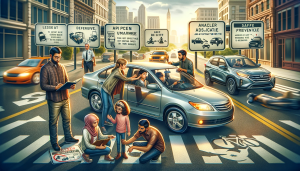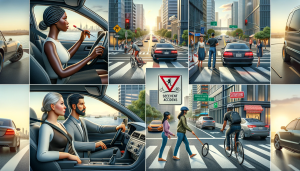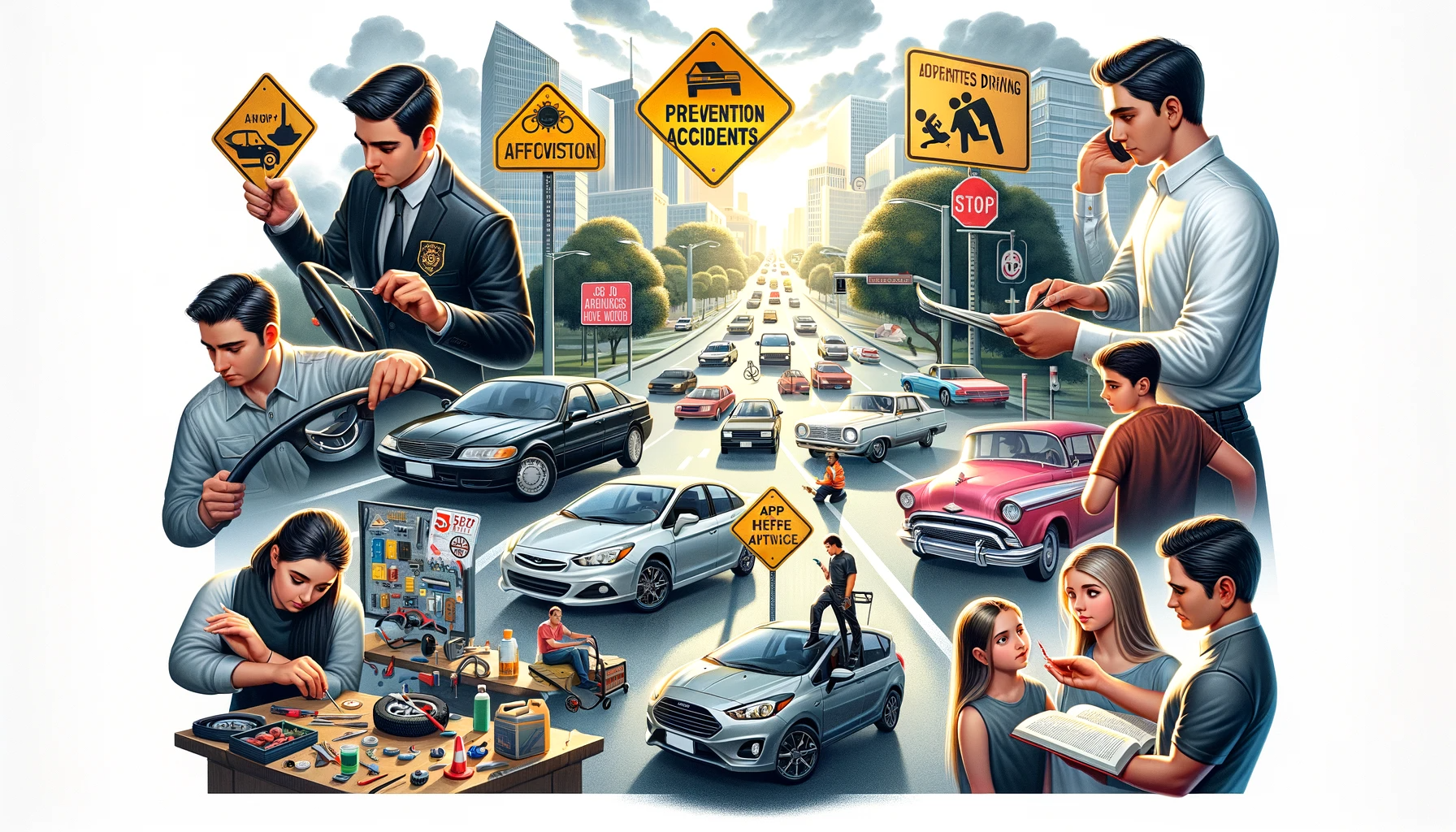Have you ever been behind the wheel and found your heart skipping a beat as a near-miss unfolded before your eyes? It's a stark reminder that the road is unpredictable, and safety should never take a backseat. Whether you're a seasoned driver or a newcomer to the asphalt jungle, these 5 essential tips will steer you towards safer travels while providing a more detailed exploration of each aspect to create a comprehensive guide on road safety.


Understanding Road Safety Tips
Before you even turn the ignition, it's crucial to grasp the basics of road safety. An ounce of prevention is worth a pound of cure, and that's where driver's education comes in. It's not just about passing a test; it's about instilling safe driving habits that last a lifetime. Driver's education encompasses much more than memorizing the rules of the road. It delves into the psychology of driving, teaching you to understand the human factor behind the wheel. It emphasizes the importance of maintaining situational awareness, recognizing potential hazards, and making informed decisions on the road. Navigating the roads also means abiding by traffic rules and regulations. They're not just suggestions; they're the blueprint for avoiding chaos on the streets. From speed limits to signaling, these rules are the language of the road, and fluency can save lives. Additionally, understanding the significance of defensive driving is a crucial part of road safety education. Defensive driving techniques empower you to anticipate the actions of other drivers, react effectively to unexpected situations, and maintain a safe following distance, reducing the risk of accidents.
Embracing Defensive Driving Techniques
Defensive driving is like having a sixth sense on the road. It's about being aware of your surroundings and anticipating the actions of others. Maintaining a safe following distance gives you the time to react while checking blind spots and using turn signals are the courtesies that keep everyone in sync. One of the fundamental principles of defensive driving is keeping a safe following distance. This buffer space between your vehicle and the one in front of you allows for more reaction time in case of sudden stops or emergencies. Understanding how to calculate and maintain an appropriate following distance is essential for avoiding rear-end collisions. Checking blind spots is another crucial aspect of defensive driving. Blind spots are areas around your vehicle that are not visible in your rearview or side mirrors. To ensure safe lane changes and turns, it's vital to physically check your blind spots by turning your head to glance over your shoulder before changing lanes. Using turn signals is not just a courtesy; it's a safety measure. Signaling your intentions communicates your next move to other drivers, giving them time to adjust their driving accordingly. Consistent use of turn signals helps prevent accidents by reducing confusion and ambiguity on the road.The Role of Car Safety Features
Today's vehicles come equipped with an arsenal of accident-avoidance technology. These features are your co-pilots, helping to navigate the unexpected. But technology is only as good as the maintenance behind it. Regular vehicle maintenance for safety ensures that your car responds when it matters most. Car safety features have advanced significantly in recent years, offering an extra layer of protection for drivers and passengers. These features include adaptive cruise control, lane departure warning systems, automatic emergency braking, and blind-spot monitoring, to name a few. While these technologies can assist in avoiding accidents, it's crucial to understand how they work and to keep them in optimal working condition through regular maintenance. Regular vehicle maintenance involves checking and servicing various components, such as brakes, tires, lights, and safety systems. Routine inspections and maintenance ensure that your car's safety features remain effective and reliable. Ignoring maintenance can lead to system failures and compromised safety, putting you at risk on the road.The Human Factor in Driving Safety
At the heart of driving is you, the driver. Avoiding distractions while driving is a commitment to focus that can't be understated. And let's be clear: sober driving isn't just a good idea, it's the law. Your decisions have power; wield them wisely. The human factor is perhaps the most significant aspect of road safety. Your decisions, behaviors, and state of mind play a pivotal role in your safety and the safety of others on the road. Avoiding distractions while driving is a fundamental responsibility. Distractions can be anything from texting and talking on the phone to eating or fiddling with in-car entertainment systems. Taking your attention off the road for even a few seconds can have severe consequences. Additionally, driving under the influence of alcohol or drugs is not only dangerous but also illegal. Impaired driving significantly impairs your judgment, coordination, and reaction times, making it a leading cause of accidents and fatalities. Staying sober behind the wheel isn't just a legal obligation; it's a moral responsibility to protect yourself and others.Adapting to Driving Conditions
The weather doesn't always play nice, and driving in adverse weather conditions demands respect. Slow down, turn on those headlights, and master emergency braking techniques to keep control when the skies open up. Adapting to changing driving conditions is essential for road safety. Inclement weather, such as rain, snow, fog, or ice, can significantly affect road surfaces and visibility. Slowing down and increasing following distances are critical when driving in adverse conditions. Reduced speed allows for better traction and control, while a greater following distance provides more time to react to unexpected situations. Turning on your headlights in adverse weather isn't just for your visibility; it also helps other drivers see you more clearly. Properly functioning headlights are essential for safe driving, especially during low-light or inclement weather conditions. Regularly check and replace headlights as needed to maintain optimal visibility. Mastering emergency braking techniques is another skill that can save lives in challenging driving conditions. Knowing how to apply the brakes effectively in slippery or wet conditions can prevent skidding and loss of control. Learning these techniques through driver's education or specialized training programs is highly recommended for all drivers.The Basics of Safe Driving Practices
Sometimes it's the simplest things that make the biggest difference. Speed limit adherence and seat belt usage are the ABCs of driving safety. Always be aware of road hazards, and remember, the road is full of surprises. Stay alert, stay alive. Safe driving practices are built on a foundation of basic principles that every driver should follow. Adhering to speed limits is essential for road safety. Speed limits are set based on road conditions, traffic flow, and the safety of all road users. Excessive speed reduces reaction time and increases the severity of accidents. Staying within posted speed limits not only keeps you safe but also demonstrates responsible driving behavior. Wearing seat belts is non-negotiable when it comes to safety. Seat belts are the primary safety restraints in vehicles, designed to protect occupants in the event of a collision. Properly fastened seat belts significantly reduce the risk of injury or ejection from the vehicle during an accident. Ensuring that all passengers in your vehicle are buckled up is a responsibility every driver should uphold. Being aware of road hazards and potential obstacles is essential for proactive driving. Hazards can include potholes, debris on the road, or even wildlife crossing. Staying alert and scanning the road ahead allows you to react promptly and avoid potential accidents. Remember that the road is full of surprises, and being prepared for the unexpected is a fundamental aspect of safe driving. Always be ready to react to sudden lane changes, abrupt stops, or unexpected obstacles. Defensive driving techniques, such as maintaining a safe following distance and checking blind spots, are your tools for navigating these surprises on the road.
Conclusion
Driving is a privilege that comes with responsibility. By embracing these tips, you're not just protecting yourself; you're safeguarding everyone who shares the road with you. So buckle up, stay sharp, and drive with confidence. Safe travels! In summary, road safety is a multifaceted aspect of responsible driving. Understanding the basics of road safety, including the rules and regulations, defensive driving techniques, and the importance of driver's education, forms the foundation for safe travels. Embracing defensive driving by maintaining safe following distances, checking blind spots, and using turn signals adds layers of protection. Car safety features are valuable allies in navigating the unexpected, but they require regular maintenance to function effectively. The human factor in driving safety cannot be overstated, with avoiding distractions and staying sober as crucial responsibilities for every driver. Adapting to adverse driving conditions, such as inclement weather, demands a cautious approach, including reducing speed, using headlights, and mastering emergency braking techniques. Finally, adhering to the basics of safe driving practices, like obeying speed limits, wearing seat belts, and staying alert to road hazards, ensures that you are prepared for the surprises that the road may throw your way. By incorporating these road safety tips into your driving habits, you not only enhance your safety but also contribute to the well-being of fellow road users. Remember, safety should never take a backseat; it should always be at the forefront of your mind when you're behind the wheel. Safe travels on your journey!Look for an attorney who has the right legal resources for your legal needs.
Contact us here on the Warmuth Law website or through our hotline 888-517-9888.











